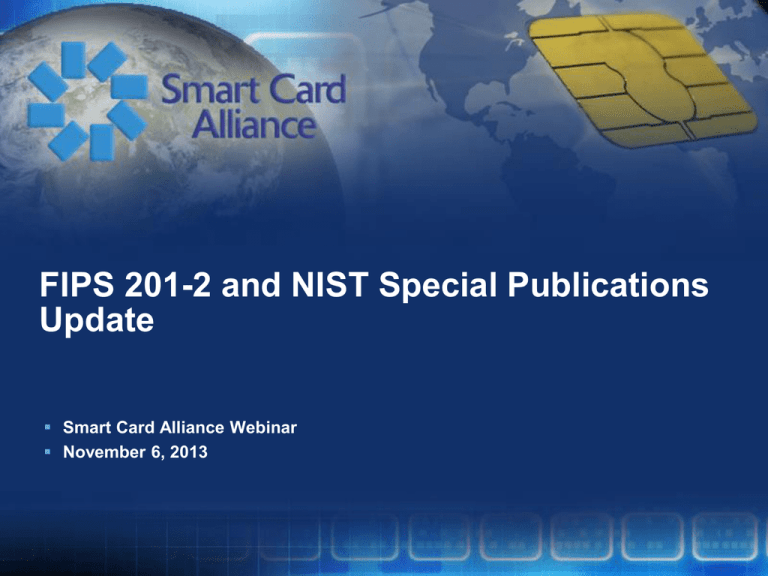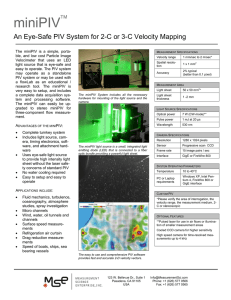FIPS 201-2 and NIST Special Publications Update
advertisement

FIPS 201-2 and NIST Special Publications Update Smart Card Alliance Webinar November 6, 2013 Today’s Webinar Topics & Speakers Introductions: Randy Vanderhoof, Executive Director, Smart Card Alliance FIPS 201-2 Update: Hildegard Ferraiolo, NIST SP 800-73: Ketan Mehta, NIST SP 800-73 Secure Messaging: David Cooper, NIST SP 800-157: Sal Francomacaro, NIST Q&A: Randy Vanderhoof, Smart Card Alliance Revision 2 of FIPS 201 (FIPS 201-2) Hildegard Ferraiolo PIV Project Lead NIST ITL Computer Security Division Hildegard.ferraiolo@nist.gov Smart Card Alliance Post Govt Conference Webinar, November 6, 2013 From FIPS 201-1 to FIPS 201-2 FIPS 201 2005 FIPS 201-2 FIPS 201-1 2006 2007 2008 2009 2010 • 2011 – Draft FIPS 201-2 & Workshop • 2012 – Revised Draft FIPS 201-2 & Workshop • 2013 – September 5th, FIPS 201-2 published 4 FIPS 201-2 Draft FIPS 201-2 Revised Draft 2011 2012 2013 Final FIPS 201-2 What is different from FIPS 201-1? Issuer 5 PIV Card Issuer’s Perspective 6 PIV Issuer Viewpoint – The Next Gen PIV Card FIPS 201-1(superseded) Mandatory - PIV Authentication - CHUID - Biometric (fingerprints) Optional - CAK - Digital Signature Key - Key Management Key, - Facial Image FIPS 201-2 (in effect): Mandatory - PIV Authentication - CHUID - Biometric (fingerprints) - CAK - Digital Signature Key, - Key Management Key - Facial Image Optional OCC, Biometric (iris) 7 In Depth Technical Details ….. – – – – – SP 800-73-4 (Revision in process) SP 800-78-4 (Revision in process) SP 800-76-2 (Revision complete) SP 800-85 A / B (Revision in process) SP 800-79-2 (Revision TBD) 8 Compliance Perspective 9 Effective Date and Implementation Schedule of FIPS 201-2 (as coordinated with OMB) • Effective Date: “This Standard is effective immediately and supersedes FIPS 201-1 (Change Notice 1). New optional features of this Standard that depend upon the release of new or revised NIST Special Publications are effective upon final publication of the supporting Special Publications.” • Implementation Schedule: “This Standard mandates the implementation of some PIV Card features that were optional to implement in FIPS 201-1. To comply with FIPS 201-2, all new and replacement PIV Cards shall be issued with the mandatory PIV Card features no later than 12 months after the effective date of this Standard.” 10 Relying Party’s Perspective 11 FIPS 201-2 - A Relying Party’s Viewpoint Authentication Mechanisms PIV Assurance LACS LACS Level Required Local Workstation Remote/Networ by k System Environment Application/Res Environment ource LITTLE or NO CHUID* VIS*, CHUID* confidence SOME PKI-CAK, SYMPKI-CAK PKI-CAK confidence CAK HIGH BIO BIO confidence BIO-A, OCC-AUTH, VERY HIGH BIO-A, OCCPKI-AUTH confidence AUTH, PKI-AUTH PKI-AUTH PACS Yellow font constitutes a change from FIPS 201-1. * Downgraded to Little or No Confidence (LoA-1) •Signature validation required on all signed credentials (i.e., BIO, BIO-A, CHUID, Certs….) •Underlined: Authentication methods suitable for inter-agency use – all PIV cards have (or will have) the credential associated with authentication method on-card. 12 In Depth Technical Details ….. – – – – SP 800-116 (Revision TBD) SP 800-73-4 (Revision in process) SP 800-78-4 (Revision in process) SP 800-76-2 (Revision complete) 13 FIPS 201-2 PIV Card Interface: Contact, Contactless and now optionally virtual contact interface – Technical Details in SP 800-73-4, SP 800-78-4, SP 800-85A-2 Form Factor: • PIV Card remains mandatory • Optionally derived PIV credentials on mobile device to enable remote IT access with mobile. - Technical Details in SP 800-157 (new), SP 800-166 (new) 14 FIPS 201-2 - Optional Chain-of-Trust and Grace Period for PIV card reissuance processes (Technical details in SP 800-156 (new), SP 800-79 ) - Relaxation of PIV Card termination requirements and specifically certificate revocation (Technical details in SP 800-79 ) - Facial image match as option for 1:1 match at re-issuance, - New options for physical card characteristics to help agencies achieve Section 508 compliance for PIV card orientation, - A UUID as a mandatory unique identifier for the PIV Card. (Technical details in SP 800-73-4 ) 15 HSPD #12 PIV Document Relationships SP 800-73-4 Public draft: May ‘13 SP 800-78-4 HSPD 12 (Presidential) Public draft: May ’13 SP 800-85A Draft update initiated SP 800-76 2 draft is done -2 (Secretary of Commerce) FIPS 201 SP 800-85B Draft update initiated SP 800-79 Draft update initiated SP 800-116 New SPs TBD Standards SP 800-156 Chain of Trust SP 800-87 Driver Draft update initiated SP 800-166 (NIST) revision in process revision complete Test Guidelines Supporting Special Publications SP 800-96 To commence 16 SP 800-157 PIV Derived Credentials Public draft - TBD PIV Derived Credentials TEST REQUIREMENT Public draft - TBD FIPS 201-2 Revision Team: From A to Z: – – – – – – – Ramaswamy Chandramouli – PIV Validation and Accreditation David Cooper – PIV Cryptographic Capabilities Hildegard Ferraiolo – PIV Program Lead and PIV Card Capabilities Salvatore Francomacaro – Change Management Patrick Grother – PIV Biometrics Ketan Mehta – PIV Authentication Mechanisms Annie Sokol – Visual PIV Card Topology 17 9/5/13 Final FIPS 201-2 Released • Announce Final FIPS 201-2 with Federal Register Notice – https://www.federalregister.gov/articles/2013/09/05/2013-21491/announcing-approval-of-federalinformation-processing-standard-fips-publication-201-2-personal • Publish Final FIPS 201-2 at csrc.nist.gov – http://nvlpubs.nist.gov/nistpubs/FIPS/NIST.FIPS.201-2.pdf (Appendix E contains Revision History) • Publish public comments and resolutions – 2011 Draft comments: – http://csrc.nist.gov/publications/fips/fips201-2/fips201_2_2011_draft_comments_and_dispositions.pdf – 2012 Draft comments – 18 http://csrc.nist.gov/publications/fips/fips201-2/fips201_2_2012_draft_comments_and_dispositions.pdf Standards - FIPS 201-2 Working together • • • • • = close alignment. Are all parties equally satisfy NIST received 1,800+ comments during the revision including: U.S. federal government organizations, State government organizations, Private sector organizations, and Private individuals Thank you! Changes to SP 800-73 (SP 800-73-4) Ketan Mehta NIST PIV Team NIST ITL Computer Security Division mehta_ketan@nist.gov Smart Card Alliance Post Govt Conference Webinar, November 6, 2013 Draft SP 800-73-4 • Removed Part 4, The PIV Transitional Data Model and Interfaces - as discussed with DoD. • Added Section 1.3 “Effective Date”. This aligns with OMB’s coordinated language in FIPS 201-2. • Made asymmetric Card Authentication key mandatory. • Made digital signature key and key management key conditionally mandatory. • Made the facial image data object mandatory. 21 Draft SP 800-73-4 • Introduced specifications for optional secure messaging. • Introduced specifications for optional virtual contact interface over which all non-card-management functionality of the PIV Card is accessible. • Added support for optional pairing code that is used to establish virtual contact interface. • Added PIV card level PIN length enforcement requirements for the PINs, pairing code and PUK. 22 Draft SP 800-73-4 • Made Card UUID mandatory. • Added optional Cardholder UUID as a cardholder unique identifier. • Added optional on-card biometric comparison mechanism as a means of performing card activation and as a PIV authentication mechanism. • Expanded Part 1, Appendix C (PIV Algorithm Identifier Discovery) to include an Algorithm Identifier discovery for Secure Messaging. • Expanded Part 2, Appendix A (GENERAL AUTHENTICATE examples) to illustrate use of VCI. 23 FIPS 201-2 and Mobility (SP 800-157 - Derived PIV Credentials) Sal Francomacaro NIST PIV Team NIST ITL Computer Security Division salfra@nist.gov Smart Card Alliance Webinar, November 6, 2013 “Mobile Revolution” • Always-on, Always-connected • Rapid innovation driven by intense competition and consumer demand • Different constraints, abilities than desktop/laptop computers • More and more Federal systems accessed by mobile devices, increasing need for strong assurance of identity 35 FIPS 201-2 and Mobility FIPS 201-2 recognizes and directly supports new Mobility trends: “Valid PIV Cards may be used as the basis for issuing derived PIV credentials in accordance with NIST Special Publication 800-157, Guidelines for Derived Personal Identity Verification (PIV) Credentials” While SP 800-157 will provide guideline on Derived PIV credential, it will not preclude the use of different technique (i.e. NFC) for the Mobile PIV ecosystem 36 SP 800-157 - Derived PIV Credentials • The scope of the Derived PIV Credential guideline is to provide PIV-enabled authentication services for high-level applications on the mobile device to authenticate the credential holder to remote systems • The guideline specifies the use of tokens with alternative form factors to the PIV card that may be inserted into mobile devices 37 SP 800-157 - Derived PIV Credentials • Derived PIV Credentials are based on the general concept of derived credential in SP 800-63 • Identity proofing and vetting processes do not have to be repeated to issue a Derived PIV Credential • Possession of a valid PIV card is the basis to issue derived PIV credential for mobile devices 38 SP 800-157 - Derived PIV Credentials • The guideline specifies and supports both LOA-3 and LOA-4 Derived PIV Credentials • The guideline doesn’t preclude the issuance of multiple Derived PIV Credentials to the same Applicant on the basis of the same PIV Card • The Derived PIV Credential is unaffected by loss, theft or damage to the Subscriber’s PIV Card 39 SP 800-157 - Derived PIV Credentials • Derived credentials may be issued to a variety of cryptographic tokens available for use on mobile devices. These tokens may be hardware or software-only implementations • Federal PKI Policy Authority will issue fpki common policies for both LOA-3 and LOA-4 Derived PIV Credential 40 SP 800-157: Cryptographic Token Types • • • • • SD Memory card* USB token* UICC (next Gen SIM card) Embedded Hardware secure element Software token * With an embedded HW crypto controller 41 PIV and Mobility: A different approach than Derived PIV Credentials Near Field Communication (NFC) • A mobile device, that supports the Near Field Communication (NFC) capability, can directly interact with the PIV card contactless interface • The user would need to hold or place the card next to the mobile to initiate the interaction between PIV card and Mobile device • FIPS 201-2 and Draft SP 800-73-4 specifications have introduced the concept of Virtual Contact Interface (VCI) to support this contactless scenario. 42 Questions & Answers • • • • • Randy Vanderhoof, rvanderhoof@smartcardalliance.org Hildegard Ferraiolo, hildegard.ferraiolo@nist.gov Ketan Mehta, ketan.mehta@nist.gov David Cooper, david.cooper@nist.gov Sal Francomacaro, salvatore.francomacaro@nist.gov Smart Card Alliance 191 Clarksville Rd. · Princeton Junction, NJ 08550 · (800) 556-6828 www.smartcardalliance.org


